Nursing Presentation / Unit 1 Introduction to Microbiology PPT
Table of Contents
Define microbiology
What is Microbiology?
Microbiology is the study of all living organisms that are too small to be visible with the naked eye. This includes bacteria, archaea, viruses, fungi, prions, protozoa and algae, collectively known as ‘microbes’.
Medical microbiology deals with the study of microorganisms responsible for various diseases of low to high intensity, and it can be divided into:
- Bacteriology, which deals with study of bacteria.
- Virology, which facilitates study of viruses.
- Parasitology, which involves unicellular to multicellular parasites.
- Mycology, that deals with various fungal microorganisms
Importance of Microbiology in Nursing Practice
Role of a nurse in relation to the condition of the patient, disease stage, diagnosis, treatment module, and hospital environment from a microbiological perspective. The role of a nurse is varied, and it is important for a nurse to multitask intellectually with fundamental knowledge, decisive thinking, and application. Evolving nurses with a conceptual clinical approach towards the following:
- Asepsis, sterilization, and disinfection
- Recognition of infection
- Infection control—pathogenesis and transmission
- Nosocomial infection
- Immune system 6. Clinical thought process.
Why Microbiology is Needed in Nursing?
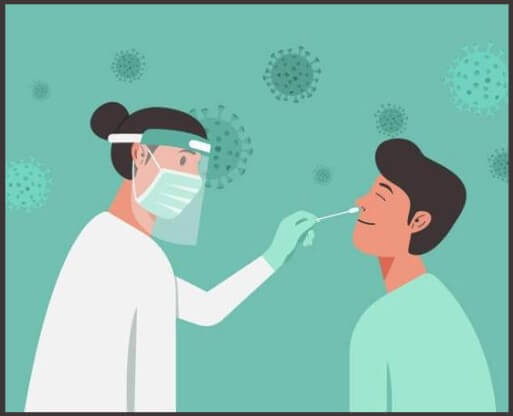
Nurses are involved in managing all aspects of patient’s health and infection control in the hospitals. A nurse must know microbiology to take care of a patient and to protect oneself from pathogenic microorganisms. Nurses utilize concepts of microbiology while giving patient care or doing procedures
To prevent spread of infection:
Nurses should have knowledge about the mode of spread of infection. Some infections are spread by contact (touch), air (air-borne), droplets (sneezing, coughing), some by eating contaminated food or drink (foodborne), sexual contact (STDs), by arthropod bite (vector born) and others by contaminated blood transfusion, etc. the knowledge would help a nurse to use particular measures to save community and hospital spread of infection
To Maintain Sterile Field:
- A nurse must know procedures used to create and maintain a sterile field in the hospitals and these are based on the knowledge of microbiology.
- The knowledge of microbiology can further help a nurse to use sterile equipment which are a necessary part of invasive procedures done on patients. The principles of asepsis are based on microbiology. The knowledge of sterilization techniques is mandatory for a nurse. The proper disposal of biomedical waste is equally important.
To collect specimens
The nurse must recognize the importance of proper collection of specimens to be sent for bacteriological examination to obtain accurate results. For instance, she has to be familiar with the various infectious disease and their route of infection to collect clinical specimen from a proper site like, pustule or blood or stool etc.
- A nurse also plays an important role in immunization to control threats of various diseases like diphtheria or MMR etc. So they must have knowledge of various antisera and vaccines used in preventing the dreadful diseases.
- The immunization schedules and the cold chain used to deliver the vaccines from the production to the administration should be known to a nurse. Knowledge of immunology makes a nurse well-prepared for vaccination and protection of vaccines by using cold chain.
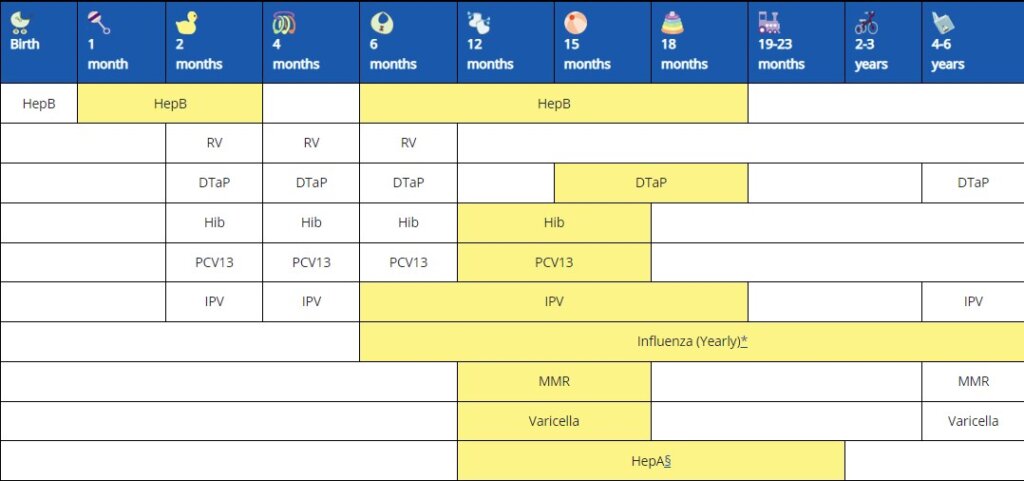
Contribution of the Following Scientists in the Field of Microbiology.

Van Leeuwenhoek (24 October 1632 – 26 August 1723)
- He is commonly known as “The Father of Microbiology“, and one of the first microbiologists.
- Van Leeuwenhoek is best known for his pioneering work in microscopy.
- Dutch businessman and scientist in the Golden Age of Dutch science and technology. A largely self-taught man in science.
- In the 1670s, he started to explore microbial life with his microscope. This was one of the notable achievements of the Golden Age of Dutch exploration and discovery (c. 1590s–1720s).
- Using single-ended microscopes of his own design and make, van Leeuwenhoek was the first to observe and to experiment with microbes.
Francesco Redi (18 February 1626 – 1 March 1697)
- Italian physician, naturalist and biologist.
- He is referred to as the “founder of experimental biology”, and as the “Father of Modern parasitology“.
- He was the first person to challenge the theory of spontaneous generation by demonstrating that maggots come from eggs of flies.
- He said simpler life forms such as worms and maggots need no parents – they emerge alive from the earth and from rotting organic matter. This idea had been accepted for over 2,000 years.
- Again, Redi used experiments to research this subject. He observed that flies laid eggs on meat. These eggs hatched into maggots. If the meat was protected from flies, no eggs were laid and no maggots appeared.
- He described his work in 1668 in Experiments on the Generation of Insects.
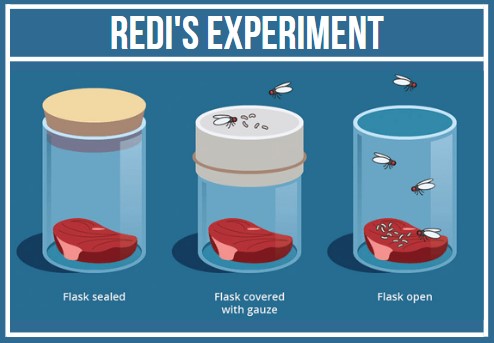
Louis Pasteur
French chemist and microbiologist renowned for his discoveries of the principles of vaccination, microbial fermentation, and pasteurization.
He is regarded as one of the founders of modern bacteriology and has been honored as the “Father of bacteriology“
Pasteur was responsible for disproving the doctrine of spontaneous generation and his experiment demonstrated that in sterilized and sealed flasks, nothing ever developed. Conversely, in sterilized but open flasks, microorganisms could grow. For this experiment, the academy awarded him the Alhumbert Prize carrying 2,500 francs in 1862.
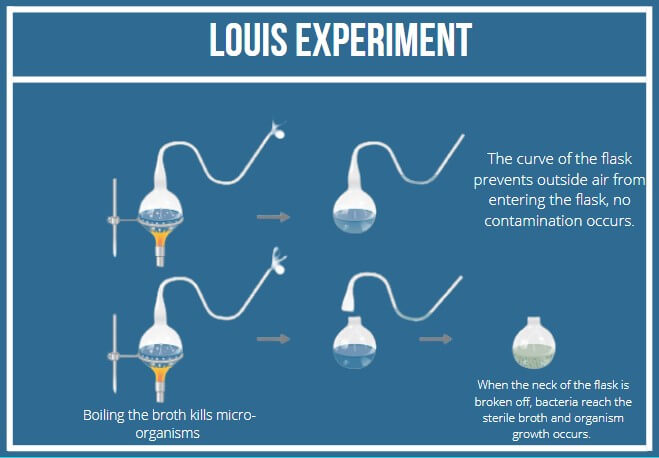
Robert Koch
German physician and microbiologist. As the discoverer of the specific causative agents of deadly infectious diseases including tuberculosis, cholera, and anthrax.
He is regarded as one of the main “founders of modern bacteriology”.
He was the first to use oil immersion lens, condenser and microphotography in microscopy.
In appreciation of his works, he was appointed as government advisor at the Imperial Health Office in 1880, promoted to a senior executive position (Geheimer Regierungsrath) in 1882, Director of Hygienic Institute and Chair (Professor of hygiene) of the Faculty of Medicine at Berlin University in 1885.
The methods Koch used in bacteriology led to establishment of a medical concept known as Koch’s postulates, four generalized medical principles to ascertain the relationship of pathogens with specific diseases.
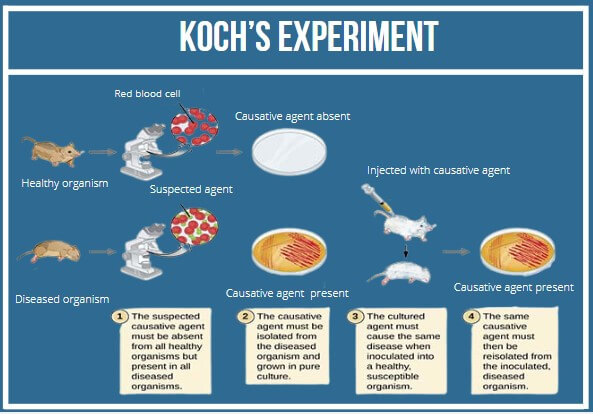
For his research on tuberculosis, he received the Nobel Prize in Physiology or Medicine in 1905.
Distinguish between eukaryotic and prokaryotic cell.
Prokaryotic
- Nucleus Absent.
- Cell Type, Usually unicellular.
- True Membrane bound Nucleus absent.
- Example: Bacteria and Archaea.
Eukaryotic
- Nucleus present.
- Cell Type, usually multicellular
- True Membrane bound Nucleus present
- Example: Animals and Plants.
List Some Basic Properties of Virus
- The size of virus ranges from (20-300) nm in diameter.
- The overall shape of virus varies in different groups of virus.
- Two basic symmetry are recognized in virus, they are helical symmetry and icosahedral symmetry.
Structure and Chemical Composition of Virus
Genome: Viral genome or nucleic acid contains either DNA or RNA but not both.
Capsid: Composed of capsomere. Capsid protects the nucleic acid and also helps in attachments on host cell surface during infection.
Envelope: Some virus contains phospholipid bilayer known as envelope.
Glycoprotein spike: Envelope of some virus contains viral coded spike projected outside the envelope called glycoprotein spike or peplomers.
Enzymes: Some viruses possess their own enzymes. Retrovirus possess reverse transcriptase.
Viral replication: Virus only replicates inside host cell.
Metabolism: Viruses are metabolically inert outside host cell. They are also called as obligate intracellular parasite.
Resistance:
Temperature: Most viruses are heat labile.
Cold: Viruses are stable and resistant to cooling. Virus can be stored for long duration at -40 °C to -70 °C by lyophilization or freeze drying.
Radiation: Both non-ionizing and ionizing radiation can kill virus.
Organic solvent: Chloroform, ether and bile salt can destroy all viruses by lipid solution.
Disinfectant: Most viruses are destroyed by oxidizing agents such as chlorine, H2O2, iodine etc.
Antibiotics: Viruses are resistant to antibiotics.
List of Basic Nutritional Requirements of Microorganism
In order to get energy and to maintain cellular biosynthesis, every organism must be provided with the essential substances needed for growth from its environment.
Most bacteria can be grown away from their natural habitats in laboratories if suitable nutrients are provided in the form of culture media.
Some are obligate intracellular parasites of other cells. The host cells must satisfy the nutritional requirements of mutualisms and parasites as these are the residents of the host
Major Elements
The nutritional requirements of elementary level.
The cell’s elementary composition consists of C, H, O, N, S, P, K, Fe, and Ca and traces of Zn, Ni, Mn, Co, Cu, and Mo.
Some bacteria uptake these elements as water, as some inorganic ions, microelements, and macro elements. These elements serve as either functional or structural units of the bacterial cell.
Classify Bacteria on the Bases of their Nutritional Requirement and Morphology
Microbial Nutrition: In order to get energy and to maintain cellular biosynthesis, every organism must be provided with the essential substances needed for growth from its environment. These essential substances required for bacterial growth are referred to as ‘nutrients’
Autotrophic Bacteria: The bacteria that can synthesize organic food from inorganic substances are called autotrophs. Autotrophic bacteria are of two types, which are mentioned below
Photoautotrophic Bacteria: These bacteria contain photosynthetic pigments in thylakoids that utilize the solar energy to synthesize food. Bacterial photosynthesis is completely different from that of green plants. As a result, this process is known as an oxygenic photosynthesis.
CO2 + H₂ S + Sunlight → Sugar + Sulphur + Water
Chemoautotrophic Bacteria: Chemoautotrophs construct organic compounds from inorganic substances. Here, while the oxidation of inorganic substances occurs, energy gets liberated, which in turn is used to construct food, that is, organic compounds.
Example Nitrifying Bacteria: These bacteria derive energy by oxidizing ammonia into nitrates (e.g., Nitrosomonas and Nitrobacteria).
NH4 + + 2O2 → NO2 + 2H2 O + Energy
Heterotrophic Bacteria:
Heterotrophic Bacteria: Heterotrophic bacteria cannot synthesize their own food they are always dependent on external sources. The heterotrophs are of different forms, which are mentioned below:
Saprophytic organisms: Bacteria that obtain their nutritional requirements from dead and decaying matter.
Decomposition: During it, aerobic breakdown of organic matter takes place
Fermentation: Here anaerobic breakdown of organic matter occurs. Fermentation reactions are incomplete and always release foul gases.
Putrefaction, which is the breakdown of protein molecules, is also done by heterotrophs.
Symbiotic Bacteria
Some bacteria can live with other organisms in such a way that both are not harmed by each other but rather are benefitted by one another.
The cellulose-digesting bacteria that live in the alimentary canal of ruminant mammals such as cows and goats are another example. The relationship observed here is the same mutual relationship as can be seen in E. coli residing in the human alimentary canal
Parasitic Bacteria:
Synthesize their own food and always need a host for their survival. These bacteria obtain their food from their hosts, such as animals and plants. The majority of parasitic bacteria are pathogens and are responsible for several chronic diseases in the host by exploiting them
Bacterial Morphology
Bacteria are microscopic living organisms that are structurally very simple. They are strictly unicellular and thrive solitarily. However, some bacteria are found living in groups.
Bacteria range from 1 mm in diameter (the largest end of the scale) to 200 nm in length (the smallest end of the scale).
Shape of Bacterial Cell:
Bacterial cells vary in shape and fundamentally are of four groups, which are as mentioned below.
Spherical Type: Cells are circular in shape. This type of cells are termed as ‘cocci’ are of different forms as mentioned below:
1. Micrococcus (if the coccus is single)
2. Diplococcus (if the coccus lives in pairs)
3. Streptococcus (if the coccus exists in chains)
4. Staphylococcus (if the coccus occurs in clusters, i.e., grape-like)
5. Sarcina (cubical packets of eight or more)
Bacillus Type: The cells are elongated and rod-like, and such cells are called ‘bacilli’. Bacilli may again be of different types. They might be single, in pairs, or in groups to form a chain (streptobacilli).
Spirillum Type: The cells are spirally coiled and hence referred to as spirillum. Some of the important genera that fall under this type are Spirillum and Microspira.
Vibrio Type: The cells are comma-shaped. The rod-shaped cell is curved at one end and hence appears like a ‘comma’. Vibrio cholerae is an important species of this type.
Some bacteria tend to change their shape according to environmental changes. Such bacteria fall under two categories, which are as follows:
Monomorphic: Here, the bacterium exhibits only a single shape.
Polymorphic or pleomorphic: The bacterium exhibits different shapes as the environmental or physiological condition gets changed. Examples of polymorphic bacteria are Corynebacterium diphtheriae and Mycoplasm.
Resources:-
Society, M. (n.d.). What is microbiology? What is Microbiology? | Microbiology Society. Retrieved April 22, 2022, from https://microbiologysociety.org/why-microbiology-matters/what-is-microbiology.html
Home. Famous Scientists. (n.d.). Retrieved April 22, 2022, from https://www.famousscientists.org/francesco-redi/
Wikimedia Foundation. (2022, March 28). Antonie van Leeuwenhoek. Wikipedia. Retrieved April 22, 2022, from https://en.wikipedia.org/wiki/Antonie_van_Leeuwenhoek

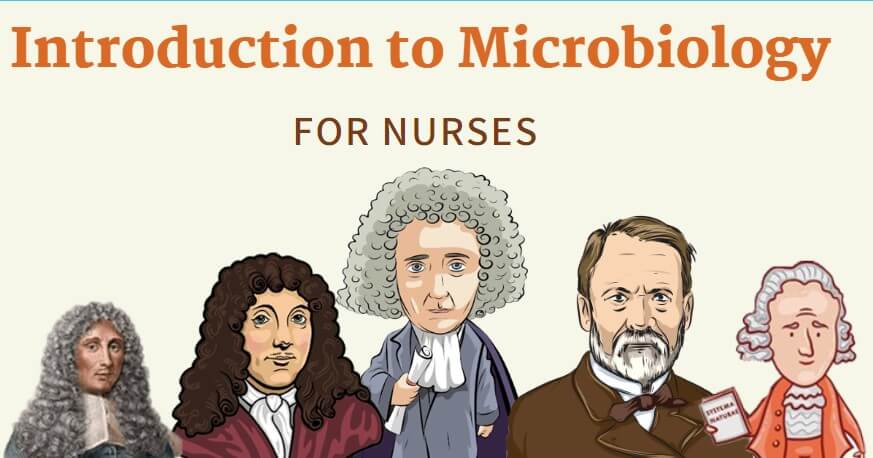
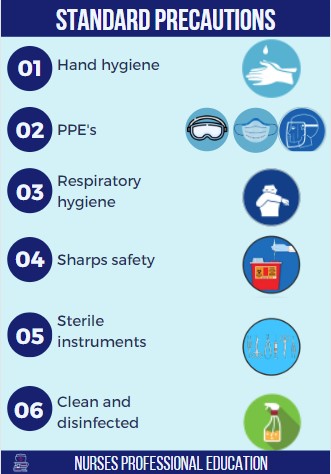
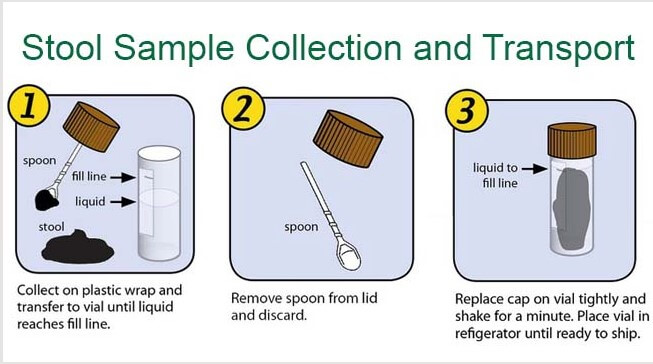
A very interesting blog, factual and balanced. I have been checking in regularly since today. Regards
🙂
Thank you very much.
Fantastic text Bravo! I especially liked the graphic design of your blog 🙂 feel free to visit me
Do you have a nice blog and interesting content on it or will everything fit on the server? you phrase the words beautifully and make you think with this commentary, good luck
Good post. I previousally to spend alot of my time water skiing and watching sports. It was quite possible the best sequence of my past and your content kind of reminded me of that period of my life. Cheers
Thanks to you for this post, it is substantive and factual, it uplifts and inspires. Keep it up!